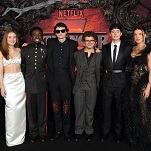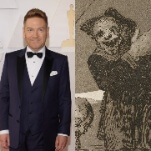What we talk about when we talk about Girls
If Girls’ first season was the show announcing its presence to the world, then the second season was when it abruptly became the one show viewers had to watch if they wanted to keep up with the cultural conversation. The HBO series and its creator, Lena Dunham, landed on magazine covers, seemingly every other New York Times arts section, and the stages of awards ceremonies. Never mind that the show’s ratings—no longer benefiting from the lead-in of Game Of Thrones, as they had in season one—actually dipped. (Though a substantial portion of the show’s audience watches on HBO Go, so the network likely doesn’t care all that much who’s watching on Sunday nights.) None of that mattered. Everyone who wanted to be a part of the cultural dialogue of the moment had to have an opinion on Hannah’s weekend with the dreamy doctor or Adam’s ejaculate in the season’s penultimate episode. You couldn’t just watch Girls. Love it or hate it, you had to be more engaged with it than any other show on TV, to explain exactly what you thought of every single scene.
I love Girls. To me, there are only two or three shows that have aired in recent months that have inspired the kind of devotion and fervor I’ve dedicated to this season, and even I will admit this is all a little silly. Not since the heyday of Mad Men and Gossip Girl has so much ink been spilled for a show so few people watched! But right around the season’s fifth episode, the beautifully shot idyll between Patrick Wilson’s character and Hannah, something dawned on me: When I describe something about the show that I like—be it the series’ emotionally unpredictable storytelling or the way that its character arcs veer all over the place—then act as if that’s a self-explanatory reason to love the show, there are just as many who see those things as self-evident reasons to dislike it. The things that make Girls what it is are so deeply ingrained in its DNA—and so confounding to so many people—that it’s possible for me to explain something about the show and say that’s why I like it so much, and for you to agree with me in every detail and see that as a reason to hate the show.
So let’s pull back a bit. Let’s not worry about the phenomenon or the Rolling Stone cover article or the time Lisa Lampanelli tweeted a racial slur to describe her relationship to Lena Dunham. Instead, let’s just presume that if a cultural artifact draws this much attention—positive and negative—it usually means there’s something to it. It doesn’t mean everyone has to like it or agree with what it’s trying to do. It’s even possible to think everybody who’s trying to defend said artifact is a total numbskull. But if something is worth discussing in earnest—and Girls discussions in both directions are hyper-earnest—then it usually means there’s something at its core that stirs up wild differences of opinion on all sides. If a show is worth discussing beyond snark, if it’s worth looking at as something more than a bland mediocrity, then that show is worth appreciating, even for those who don’t like it. I, for instance, pretty much hate The Following, but I’m glad that it exists so I can have discussions with the show’s super-fans about what makes them so attached to it. This is all good. We need more of it.
What’s so different about the reaction to Girls is the belief by so many who dislike the show—for often valid reasons—that those who like it are letting go of their critical faculties. This is an attitude that tends to crop up more in comments sections than critical writing about the show, since critics are pretty uniformly gaga for it, even when we think the show makes weird missteps. It’s also an understandable reaction to the flood of good reviews and uncritical press, which includes a huge number of puff pieces. To say that everybody else has taken leave of their faculties often seems to make more sense than saying that our theoretical viewer doesn’t see in Girls what everybody else does. But it also denies the subjectivity of human experience, the fact that we all see things differently—and the fact that that’s okay.







































